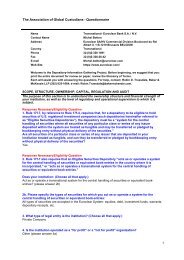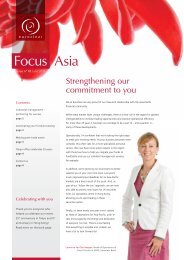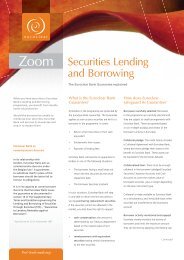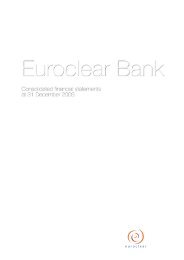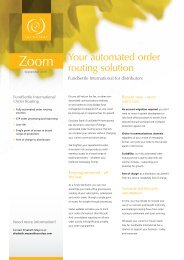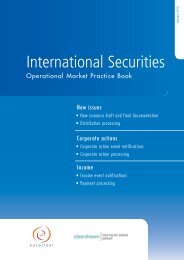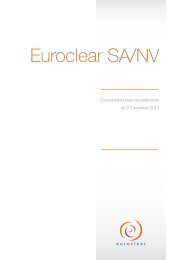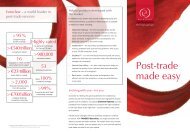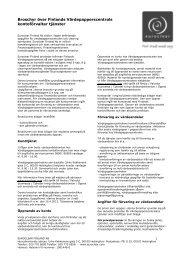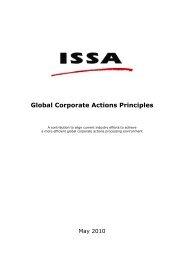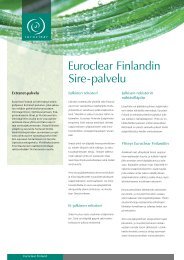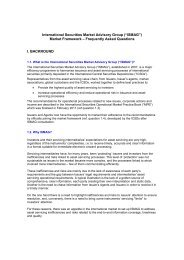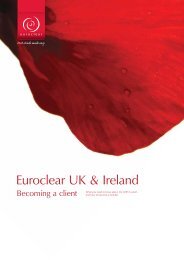Are you ready for T2S? - Euroclear
Are you ready for T2S? - Euroclear
Are you ready for T2S? - Euroclear
You also want an ePaper? Increase the reach of your titles
YUMPU automatically turns print PDFs into web optimized ePapers that Google loves.
<strong>Are</strong> <strong>you</strong> <strong>ready</strong><br />
<strong>for</strong> <strong>T2S</strong><br />
Edwin De Pauw looks at<br />
the many questions firms<br />
are facing and how best<br />
to prepare <strong>for</strong> TS<br />
Edwin De Pauw,<br />
Director, <strong>T2S</strong> Product Management, <strong>Euroclear</strong>
<strong>Euroclear</strong> considers<br />
the options that market<br />
participants are considering in<br />
the run-up to <strong>T2S</strong>.<br />
<strong>Are</strong> <strong>you</strong> <strong>ready</strong><br />
By Edwin De Pauw, <strong>Euroclear</strong><br />
Target2-Securities (<strong>T2S</strong>) is scheduled to go live in about two years, with the first migration<br />
wave <strong>for</strong> central securities depositories (CSDs) planned <strong>for</strong> June 2015. In<strong>for</strong>mation from the<br />
ECB regarding the timing of the waves is common knowledge. However, banks and other<br />
financial institutions have yet to take many <strong>T2S</strong>-related decisions that could have a significant<br />
impact on how effectively they will work in the changing post-trade environment in Europe.<br />
Making the most of <strong>T2S</strong><br />
<strong>T2S</strong> offers opportunities to centralise liquidity and reduce the cost of cross-border settlement.<br />
Along with <strong>T2S</strong>, removal of the repatriation rule <strong>for</strong> collateral mobilisation to central banks will<br />
allow firms to post collateral from any qualifying CSD to a central bank of their choice.<br />
As if preparing <strong>for</strong> <strong>T2S</strong> was not enough, new regulations will also have an impact on<br />
financial institutions. Basel III, EMIR, AIFMD/UCITS are but a few examples. Meeting these<br />
challenges while confronted with continuous cost-containment pressures will <strong>for</strong>ce some<br />
in the securities industry to either exit the business or develop new business models. Some<br />
will go up the value chain, while others will turn to partners to deliver part of their service<br />
portfolio. We also expect further consolidation among CSDs, although we may see the<br />
arrival of new CSDs initially.<br />
The right way <strong>for</strong>ward<br />
So, how should a financial institution approach <strong>T2S</strong> The first and perhaps most obvious<br />
assessment to be made should be how <strong>T2S</strong> is likely to impact their day-to-day business. The<br />
conclusions will, of course, differ depending on the current business and operating models<br />
of the financial institution. However, we believe thinking should focus on three areas.<br />
First is to assess the impact of mandatory changes generated by <strong>T2S</strong> such as mandatory<br />
trade matching and settlement lifecycle management in some markets following the<br />
introduction of a ‘hold and release’ mechanism. Second is to evaluate the impact of the<br />
timing and breadth of the various harmonisation initiatives encompassing corporate actions,<br />
market claims and the like. Last but not least is to consider the opportunities created by <strong>T2S</strong><br />
to centralise liquidity, review/rationalise the firm’s network strategy, extend services to cover<br />
more markets, exit non-profitable markets, among other possibilities.<br />
Institutions that have direct CSD relationships today may choose to make the mandatory<br />
changes now and consider how best to access <strong>T2S</strong> once they can assess the true benefits of<br />
<strong>T2S</strong>. They may wind up paying twice, but they will manage the uncertainties of <strong>T2S</strong> better.<br />
Another option is to anticipate the benefits of <strong>T2S</strong> and make the necessary changes up front to<br />
access <strong>T2S</strong> in all or some CSD-direct markets, with the risk that the benefits will not materialise<br />
at the same pace as the investments. This option, we believe, will be most relevant to firms that<br />
have direct relationships with multiple CSDs as it will reduce the need <strong>for</strong> multiple adaptation<br />
projects. A new option that may be appealing to these firms is to work through a single ‘investor<br />
CSD’ to access all or some <strong>T2S</strong> markets, rather than maintaining multiple CSD relationships.<br />
2 <strong>Are</strong> <strong>you</strong> <strong>ready</strong>
An ‘investor CSD’ enables its clients to hold<br />
pan-European assets on its books based on<br />
links established with the CSDs where the<br />
securities have been issued. The option of<br />
selecting an investor CSD removes a large<br />
part of the operational burdens associated<br />
with maintaining multiple CSD (or multiple<br />
custodian/agent) relationships. It can also<br />
eliminate the need to develop in-house<br />
expertise to provide collateral management<br />
and other asset services <strong>for</strong> client holdings<br />
of <strong>for</strong>eign assets.<br />
The thinking process will be different <strong>for</strong><br />
firms that have indirect CSD relationships<br />
today. Clearly, the introduction of <strong>T2S</strong> is<br />
an opportunity to review and potentially<br />
rationalise their current network of service<br />
providers. Perhaps one of their current<br />
providers can shield them from having to<br />
make the changes associated with <strong>T2S</strong>,<br />
thereby limiting the need to make changes.<br />
Success will depend on the firm’s ability to<br />
capture the right business opportunities while<br />
keeping costs under control to profit from<br />
them. Let’s not underestimate this important<br />
part of the decision-making process.<br />
Here, <strong>T2S</strong> poses a considerable challenge.<br />
<strong>T2S</strong> implementation costs will be huge.<br />
Market infrastructures, <strong>for</strong> example, will<br />
spend €1 billion in addition to the €1 billion<br />
to be spent by the European Central Bank.<br />
Thus, the balance between pursuing the<br />
<strong>T2S</strong> business case versus other business<br />
objectives, such as cost containment, will<br />
be an individual firm decision.<br />
Key decision criteria<br />
Firms considering how best to connect to<br />
<strong>T2S</strong> and work with a partner to service<br />
multi-market <strong>T2S</strong>-eligible assets will need<br />
to match their business needs with their<br />
capacity and internal resources. The<br />
thinking process also will be influenced by<br />
cost and risk issues, the firm’s perceptions of<br />
<strong>T2S</strong> benefits, underlying client expectations<br />
and central bank requirements.<br />
When considering the best approach,<br />
including the choice of a partner, the key<br />
criteria to consider during the thinking<br />
process are as follows:<br />
• Service level/market coverage: What<br />
service/support levels do <strong>you</strong> expect<br />
from the partner Which markets do<br />
<strong>you</strong> wish to cover Where are <strong>you</strong>r<br />
counterparties likely to be located<br />
Can the provider meet <strong>you</strong>r settlement,<br />
asset servicing, liquidity and collateral<br />
management obligations <strong>for</strong> <strong>you</strong>r<br />
domestic and cross-border activities<br />
• Access to liquidity: Do <strong>you</strong> have access<br />
to euro central bank money or do<br />
<strong>you</strong> want to rely on a commercial<br />
credit provider Can the provider give<br />
<strong>you</strong> access to liquidity in each of the<br />
markets <strong>you</strong> want to cover<br />
• Risk protection: Which type of business<br />
partner will provide the best and most<br />
comprehensive asset protection to<br />
enable <strong>you</strong> to comply with increasingly<br />
strict regulation Which provider will<br />
best meet <strong>you</strong>r liabilities requirements<br />
• All-in cost: Does the provider offer<br />
fee-related economies of scale and<br />
have low running costs Which<br />
provider can best shield <strong>you</strong> from<br />
current and future investment costs<br />
Firms that al<strong>ready</strong> work with ICSDs, agent<br />
banks and other intermediaries have a head<br />
start on others that need to begin a due<br />
diligence study to select the right partner.<br />
Time-to-market<br />
management<br />
Time-to-market will be critical when<br />
considering the above questions. Financial<br />
institutions will need to have made all the<br />
mandatory <strong>T2S</strong>-related changes - or have<br />
appointed a partner to share the burden<br />
- to be able to keep their ‘licence to<br />
operate’. Equally important, they will need<br />
to be <strong>ready</strong> to defend their competitive<br />
position and take advantage of business<br />
growth opportunities.<br />
These challenges are intensified by<br />
uncertainties relating to the timing and<br />
breadth of market-practice harmonisation<br />
initiatives and the timeline <strong>for</strong> removal of<br />
the remaining legal and fiscal barriers.<br />
Roughly speaking, during the summer of<br />
2013, firms will need to propose budgets<br />
<strong>for</strong> 2014 to start their <strong>T2S</strong> development<br />
work, even though insufficient in<strong>for</strong>mation<br />
will be available to take final decisions on<br />
market coverage, precise service offerings<br />
and pricing.<br />
We expect that most critical decisions will<br />
need to be taken in 2014/2015. By then,<br />
most in<strong>for</strong>mation will be available <strong>for</strong> firms<br />
to decide definitively if and how they intend<br />
to evolve their business model and service<br />
portfolio. They will also know what budget<br />
will be necessary to fulfil their ambitions.<br />
Flexibility in this changing environment will<br />
be important as we expect more technical<br />
and operational changes to come be<strong>for</strong>e<br />
the first <strong>T2S</strong> ‘go-live’ date.<br />
Is outsourcing an option<br />
As settlement becomes a commoditised<br />
service, more firms may consider selfsettlement.<br />
However, partnering with<br />
experts in asset servicing and collateral<br />
management can be a wise decision.<br />
On the asset servicing side, it is fair to say<br />
that except <strong>for</strong> the Belgian, Dutch and<br />
French markets, which al<strong>ready</strong> operate on<br />
a single plat<strong>for</strong>m with harmonised market<br />
practices, other European markets have yet to<br />
harmonise to a common European standard.<br />
Many financial institutions al<strong>ready</strong> work<br />
with agent banks, multiple CSDs and<br />
ICSDs to bridge these market practice<br />
gaps. As said earlier, <strong>T2S</strong> will provide the<br />
<strong>Are</strong> <strong>you</strong> <strong>ready</strong> 3
opportunity to rationalise and examine<br />
the need <strong>for</strong> large intermediary networks.<br />
That said, we are convinced that many<br />
banks and other financial institutions will<br />
continue to appoint an agent or ICSD<br />
to help them access multiple European<br />
markets and beyond because it simply<br />
makes good business sense.<br />
Market infrastructures are opening their<br />
architecture to extend their plat<strong>for</strong>ms and<br />
operational expertise, to eliminate the need to<br />
create what al<strong>ready</strong> exists. Market participants<br />
benefit from additional economies of scale<br />
and cost mutualisation opportunities.<br />
Where are <strong>you</strong><br />
Let’s look at how different business<br />
segments could consider their options.<br />
Custodian businesses may want to hold<br />
securities in or as close to the ‘issuer<br />
CSD’ as possible and want to centralise<br />
their central bank money liquidity <strong>for</strong> all<br />
<strong>T2S</strong> markets. Those custodians might<br />
be looking <strong>for</strong> a provider that offers<br />
direct access to CSDs and central bank<br />
money liquidity, and highly competitive<br />
settlement, asset servicing and collateral<br />
management services.<br />
the options <strong>for</strong> their own activity and<br />
assets, but <strong>for</strong> their underlying clients as<br />
well, some of which are al<strong>ready</strong> insisting<br />
on segregated account structures. Global<br />
custodians and ICSDs have worked handin-hand<br />
<strong>for</strong> decades and we suspect this<br />
will continue in a <strong>T2S</strong> environment. In fact,<br />
we are seeing many partnerships between<br />
global custodians and <strong>Euroclear</strong> Bank <strong>for</strong><br />
collateral management services in the<br />
run-up to <strong>T2S</strong>.<br />
Broker-dealer businesses will require a<br />
top-class service to ensure high settlement<br />
efficiency, very rapid turn around time,<br />
wide access to trading counterparties<br />
and seamless access to financing through<br />
efficient collateral management services.<br />
Depending on settlement activity scale and<br />
breadth, inhouse expertise and capacity,<br />
self-settlement at the launch of <strong>T2S</strong> or<br />
thereafter may be appealing.<br />
It may be necessary to have direct CSD<br />
access <strong>for</strong> certain markets, with a provider<br />
that can manage CSD relationships <strong>you</strong><br />
choose not to manage <strong>you</strong>rself. It would<br />
be important to select a partner that can<br />
evolve with <strong>you</strong>, without imposing sizeabe<br />
transition costs, to manage <strong>T2S</strong>-related<br />
uncertainties, such as the level of CSD<br />
interoperability that will need to evolve.<br />
to benefit from <strong>T2S</strong>. Nevertheless, there<br />
are some crucial decisions that are al<strong>ready</strong>,<br />
or should be, under consideration by<br />
securities professionals.<br />
We are confident that <strong>Euroclear</strong> can<br />
accommodate any <strong>T2S</strong> scenario that<br />
securities professionals decide is the best<br />
<strong>for</strong> them in this changing environment.<br />
There is no other group of CSDs in Europe<br />
that will be as connected to <strong>T2S</strong> as <strong>you</strong><br />
will find at <strong>Euroclear</strong>, as <strong>Euroclear</strong> Belgium,<br />
<strong>Euroclear</strong> Finland, <strong>Euroclear</strong> France and<br />
<strong>Euroclear</strong> Nederland will all be migrating<br />
to <strong>T2S</strong>. Each of them will provide entry to<br />
<strong>T2S</strong>, with a range of relevant services. Easy<br />
access to non-<strong>T2S</strong> markets, such as the UK<br />
and Eurobond markets, also need to be<br />
brought into the picture.<br />
<strong>T2S</strong> time-to-market is fast approaching.<br />
Deciding <strong>you</strong>r way in, and how much<br />
ef<strong>for</strong>t it will take, is clearly an agenda item<br />
<strong>for</strong> 2013.<br />
This article is reprinted with the kind<br />
permission of International Securities<br />
Services magazine.<br />
Global custodians will be attracted by the<br />
largest pools of liquidity. <strong>T2S</strong> is unlikely to<br />
change this fact, although it remains to be<br />
seen whether <strong>T2S</strong> will - drastically - change<br />
the location of liquidity pools <strong>for</strong> some<br />
domestic securities.<br />
For example, in certain <strong>T2S</strong> markets such<br />
as France, liquidity is to be found locally,<br />
encouraging those firms that are active in<br />
French securities to have direct access to<br />
the local issuer CSD. In other cases, such<br />
as German bunds, a significant part of<br />
Bund trading activity settles on the books<br />
of <strong>Euroclear</strong> Bank, the ICSD.<br />
Global custodians will not only consider<br />
Firms that today specialise in a given<br />
domestic market and look to target<br />
non-domestic business growth<br />
opportunities will want to leverage their<br />
domestic CSD relationship in order to<br />
access and service other <strong>T2S</strong> market<br />
securities. While not wanting to have<br />
direct CSD relationships in all markets, they<br />
may consider an ‘investor CSD’ approach.<br />
Partnering on the <strong>T2S</strong><br />
journey<br />
With differing business objectives and<br />
priorities, there is no ‘one-size fits all’<br />
solution <strong>for</strong> the many avenues of approach<br />
© 2013 <strong>Euroclear</strong> SA/NV – 1 Boulevard du Roi Albert II, 1210 Brussels, Belgium – Tel: +32 (0)2 326 1211 – www.euroclear.com –<br />
RPM Brussels number 0423 747 369 – <strong>Euroclear</strong> is the marketing name <strong>for</strong> the <strong>Euroclear</strong> System, <strong>Euroclear</strong> plc, <strong>Euroclear</strong> SA/NV and<br />
their affiliates. If at any time in the future <strong>you</strong> prefer not to receive communications from <strong>Euroclear</strong> advising <strong>you</strong> of <strong>Euroclear</strong> products<br />
and services that may be of interest to <strong>you</strong>, please contact us at Data_Protection_Officers@euroclear.com and specify on what product<br />
or service <strong>you</strong> no longer wish to receive marketing in<strong>for</strong>mation.<br />
MA2862<br />
<strong>Euroclear</strong> is a carbon neutral company – PAS2060 certified in 2013<br />
www.euroclear.com



